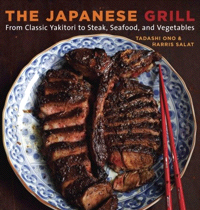It is grilling time.
How do you know?
The weather is warm enough to cook outdoors, the mosquitoes are yet to waken, and the new crop of grilling cookbooks are out.
The Japanese Grill: From Classic Yakitori to Steak, Seafood, and Vegetables by Tadashi Ono and Harris Salat (Ten Speed 2011) is a great place to start. It has plenty of good photographs by Todd Coleman (food) and Jun Takagi (locations). Japanese grilling doesn’t mean only eating massive cuts of grilled steak – yakitori is about exploring the skewer. It does mean colorful, delicious, well-cooked food presented tastefully. The Japanese Grill is the result of the happy collision of two different cultures:
So there we were, a Japanese born chef and an American food writer hooked on Japanese food and culture, sharing a bountiful meal with Japanese flavors prepared on that icon of American casual cooking –a Webber kettle grill. (p. 2)
It is about discovering the flavors of the Japanese grill master, and then applying them to American cuts.
 The first chapter goes over Japanese ingredients from Shichimi togarashi to Yukari shiso salt (pp. 7-8). There is a chapter on grilling basics that includes an essay on Binochotan, charcoal from Japanese oak (p. 12). The Japanese use different utensils for grilling including kitchen chopsticks and a hand fan. The heart of Japanese grilling is Yakitori, small bits of meat, mainly chicken, flavored with salt or tare and then other flavorings. It is very similar to Ocak Basi in Turkey and other grilling methods in which small piece of meat are carefully seasoned, skewered and grilled. The recipes range from Classic Chicken Leg (p. 26), seasoned with Shichimi tagarashi to less familiar Chicken Heart (p. 32) and Chicken Tenderloins with Ume Paste (p. 36). There are also recipes for other meats and vegetables including Shiitake Mushrooms (p. 42) with lime, soya sauce, and olive oil.
The first chapter goes over Japanese ingredients from Shichimi togarashi to Yukari shiso salt (pp. 7-8). There is a chapter on grilling basics that includes an essay on Binochotan, charcoal from Japanese oak (p. 12). The Japanese use different utensils for grilling including kitchen chopsticks and a hand fan. The heart of Japanese grilling is Yakitori, small bits of meat, mainly chicken, flavored with salt or tare and then other flavorings. It is very similar to Ocak Basi in Turkey and other grilling methods in which small piece of meat are carefully seasoned, skewered and grilled. The recipes range from Classic Chicken Leg (p. 26), seasoned with Shichimi tagarashi to less familiar Chicken Heart (p. 32) and Chicken Tenderloins with Ume Paste (p. 36). There are also recipes for other meats and vegetables including Shiitake Mushrooms (p. 42) with lime, soya sauce, and olive oil.
Beyond Yakitori, The Japanese Grill tackles everything from Crispy Chicken Wings with Seven-Spice-Powder Marinade (p. 55) and lovely Miso—Glazed Quail (p. 61) with mirin, sake, and red miso. The Fish and Seafood chapter includes a recipe for Ponzu, that citrus-y seasoning that can be used in all sort of Asian dishes including Whole Red Snapper with Ponzu (p. 71) and a Yuzu Kosho Marinade that has more of kick. The citrus flavors of ponzu and yuzu go well with grilled foods – far beyond Japanese dishes.
The Meat chapter applies Japanese sauces to large cuts of meat like a Porterhouse with Garlic-Soy Sauce Marinade (p. 104) to Japanese Burgers with Wasabi Ketchup (p. 119) or Pork Chops with Yuzu-Miso Marinade. The recipes are inventive and easy to follow, as long as you stock your kitchen with some basic Japanese ingredients.
Drag out the Webber or your little hibachi and get The Japanese Grill for some inspired dinners.
Recipe: Miso-Glazed Quail
Serves 4
¼ cup plus 1 tablespoon red miso (page 6)
1 tablespoon sake
1 tablespoon mirin
1 tablespoon olive oil
2 teaspoons sansho (page 7), plus more for accent
8 boneless quail (about 3 pounds)Mix together the miso, sake, mirin, olive oil, and 2 teaspoons of sansho in a bowl to make the marinade. Pour half of the marinade into a baking dish or rimmed sheet pan; reserve the rest. Lay the quail in the marinade and flip them 4 times to generously coat the birds all over. Marinate the quail for 15 minutes at room temperature, turning once.
Preheat a grill to medium heat. Brush and oil the grate wall. Grill the quail for about 8 minutes total, starting with the breast side down and flipping the quail almost every 2 minutes, brushing on the reserved marinate after each turn. The birds will become browned and crispy when done. Rest the quail for about 2 minutes. Accent with sansho and serve.
